Merge Sort
Merge sort is a popular sorting algorithm which uses divide and conquer algorithm. Consider an array A to be sorted. We divide the array A into two parts and sort them individually. The heart of the Merge Sort is a procedure called Merge. Let’s see the Merge procedure first and then we will use Merge as a subroutine to implement Merge Sort algorithm.
Merge Procedure

Here sub-array_1 A[p,q] and sub-array-2 A[q+1,r] are sorted individually and we want to sort them as a whole.
Len1 = q-p+1andLen2 = r-q- Create two separate lists of sizes of
Len1+1andLen2+1 - Copy the two sorted part of the arrays into the lists
- Add infinity to the end of both lists (the maximum number the data structure can support)
- Take 3 pointers
i,j,kwherei&jpoint to first elements of both the lists andkpoints to the first element of the original arrayA
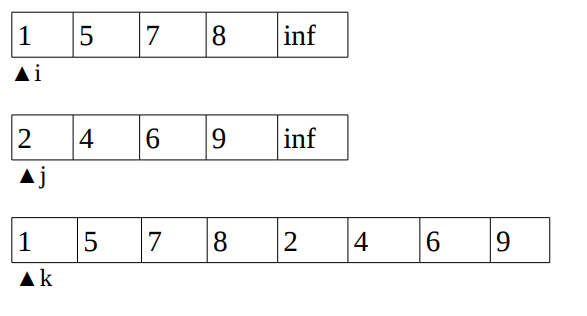
- Now we will fill the array
A(basically overwrite) in a sorted manner. - Compare the elements at
iandj. Whichever is smaller (sayi), copy its value tokthindex in arrayAand then increment pointerskandi(we consideredele(i) <ele(j)). - We repeat the above process till
kdoes not reach the end of the arrayA. - Compare
(1,2)and then incrementiandk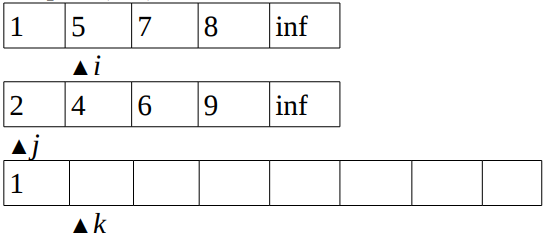
- Compare
(5,2)and then incrementjandk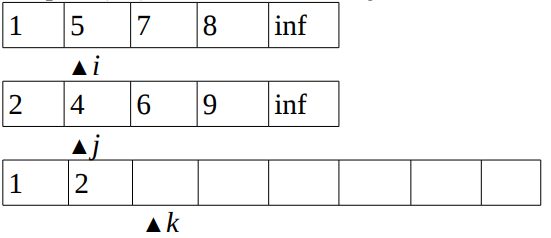
- Compare
(5,4)and then incrementjandk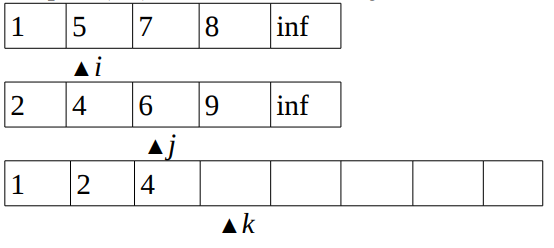
- Compare
(5,6)and then incrementiandk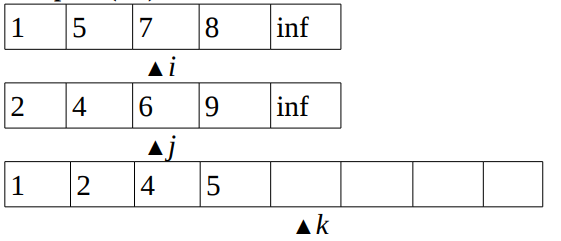
- Compare
(7,6)and then incrementjandk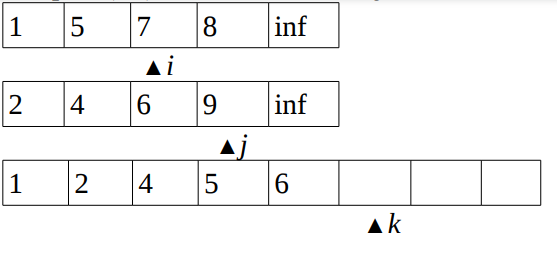
- Compare
(7,9)and then incrementiandk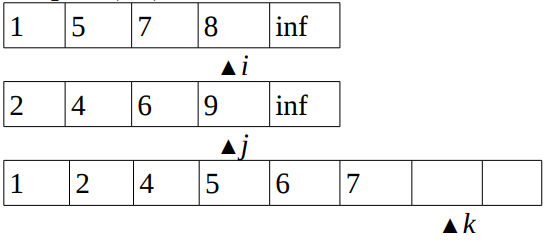
- Compare
(8,9)and then incrementiandk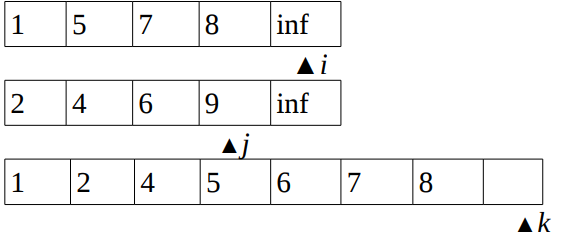
- Compare
(inf,9)and then incrementjandk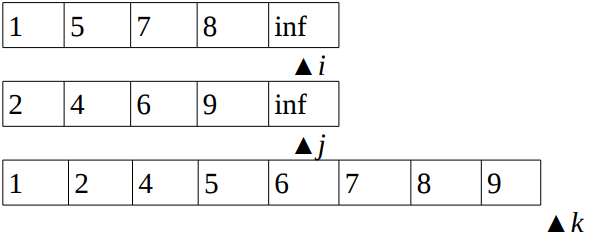
- Thus by the end of the Merge procedure the two individually sorted sub_array gets sorted as a whole in the original array A
Psuedo code for Merge Sort procedure
Merge(A, p, q, r) {
// Consider all arrays as 1-indexed arrays
n1 = q - p + 1
n2 = r - p
let Left[1.......n1 + 1] and Right[1.........n2 + 1] be two new arrays
for (i = 1 to n1) // to copy the first sorted list into array Left "O(N / 2)"
{
Left[i] = A[p + i - 1]
}
for (j = 1 to n2) // to copy the second sorted list into array Right "O(N / 2)"
{
Right[i] = A[q + j]
}
Left[n1 + 1] = inf
Right[n2 + 1] = inf
i = 1, j = 1
for (k = p to r) { // "O(N / 2)"
if (Left[i] <= Right[j]) {
A[k] = Left[j]
i++
}
else {
A[k] = Right[j]
j++
}
k++
}
}Time complexity of merge procedure
time taken = O(n/2 + n/2 + n) = O(n)
Space complexity of merge procedure:
extra space = O(n/2 + n/2) // for two extra arrays Left and Right
= O(n)
Now, we have an array A consisting on n elements. Let T(n) be the time required to sort the array.
Psuedo code for Merge sort
Merge_sort(A, p, r) {
if (p < r) {
q = floor((p + r) / 2) // find the mid point
Merge_sort(A, p, q) // T(n / 2)
Merge_sort(A, q + 1, r) // T(n / 2)
Merge(A, p, q, r) // T(n)
}
}Time complexity of merge sort
T(n) = time taken to sort n sized array
We divided the array into two n/2 sized array and sorted them individually.
So, time taken to sort those two sub arrays = T(n/2) + T(n/2) = 2T(n/2)
Merging the two arrays of size n/2 into an array of size n requires calling of the merge procedure which requires a time of O(n)
So, we come to the following recursive equation: T(n) = 2*T(n/2) + O(n)
Using Master’s theorem, we get T(n) = O(n.logn)
Recursive tree
- Consider an array with 6 elements. The array is
1-indexed, thusp=1andr=6. Let MS represent the Merge_sort function and Merge as usual represents our Merge function. - We see that the total number of function call here is 16.
- The height of the tree is
floor(log2n) + 1. Substituten = 6, we get four levels as shown
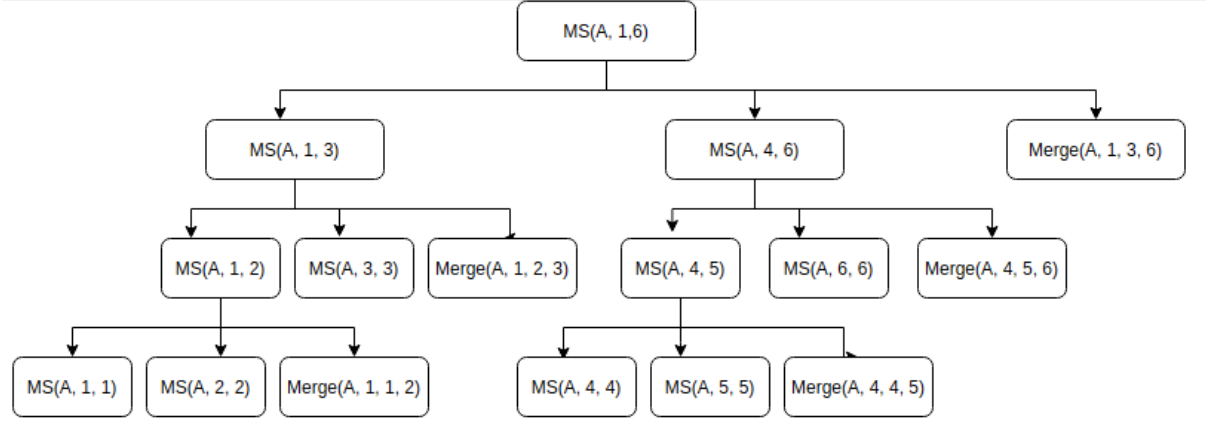
Space complexity of merge sort
- We don’t consider the space required for variables
p,q,r,i,jas they require constant space. The input array is already given. Thus, it is not considered in the extra space required category. - The procedure Merge requires two new lists of size
n/2every time it is called on an array of sizen. Instead of creating two list space every time, we can use as a global array ofO(n)space for copying of elements. It can be used by every call to procedure Merge one by one.
(1) Thus space required for Merge isO(n) - The other extra space used during merge sort is the stack space for recursive function calls.
Now in our example, for
n=6, the number of function calls was 16 - But, do we really need a stack with 16 activation records entries? Turns out, we don’t really need a stack of height 16.
All the function calls in the same level in the recursion tree ocuupy the same cell of the stack. Thus we have a stack of height equal to the height of the tree.
Height of stack = Height of the recursive tree- For n sized array
- Number of levels = floor(log2n) + 1
- Assume each cell of stack( Activation record) is ok size k.
- (2) Stack Size = (floor(log2n) + 1)*k = O(k*log2n) =
O(log2n) - From (1) and (2)
- Space Complexity = n + log2n =
O(n)
Note
- Merge sort falls under the category of out-of-place sorting algorithm since we need extra space for sorting (extra space is needed in the merge procedure, thus it is not in-place)
- Merge sort is a stable sorting algorithm as the algorithm used in our pseudo code doesn’t change the relative position of same valued elements
Help us improve this content by editing this page on GitHub